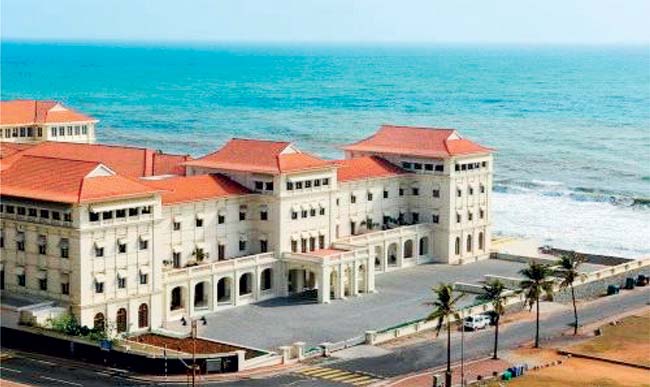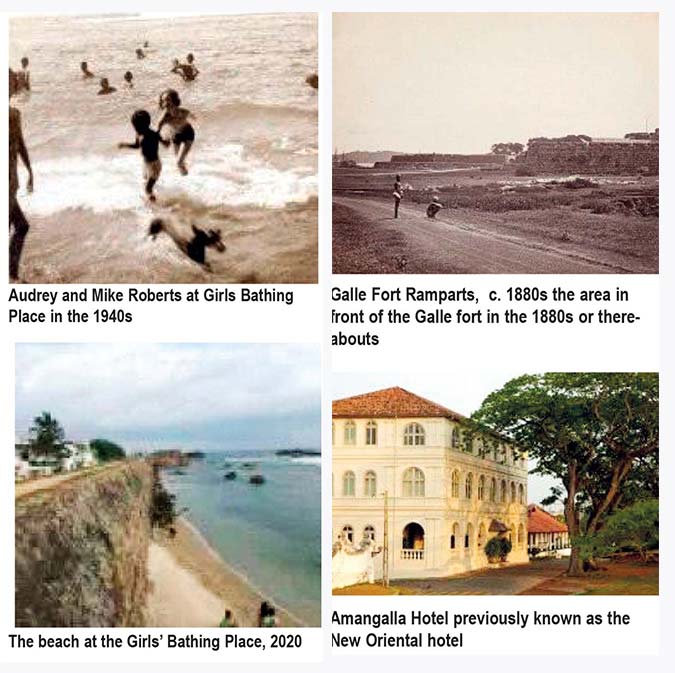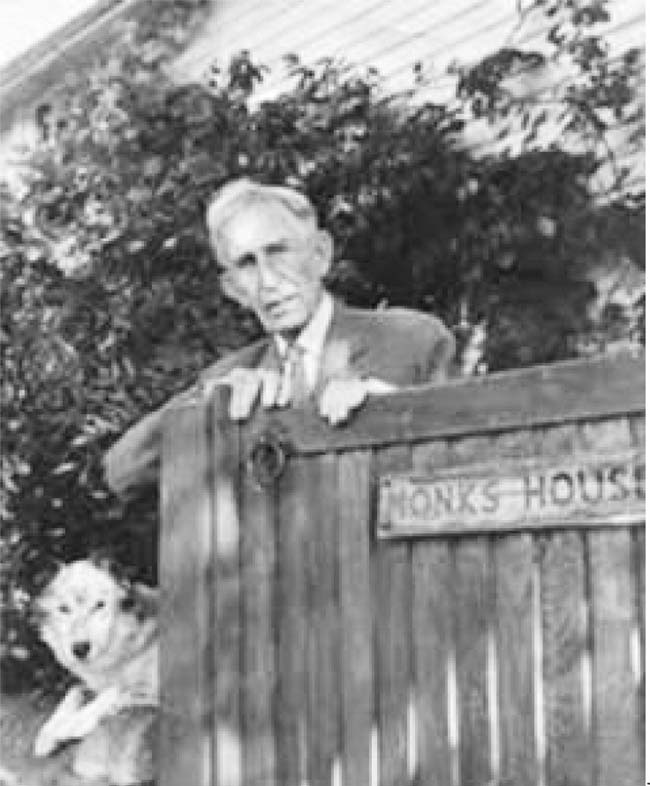Features
Heavenly Bliss in Sri Lanka
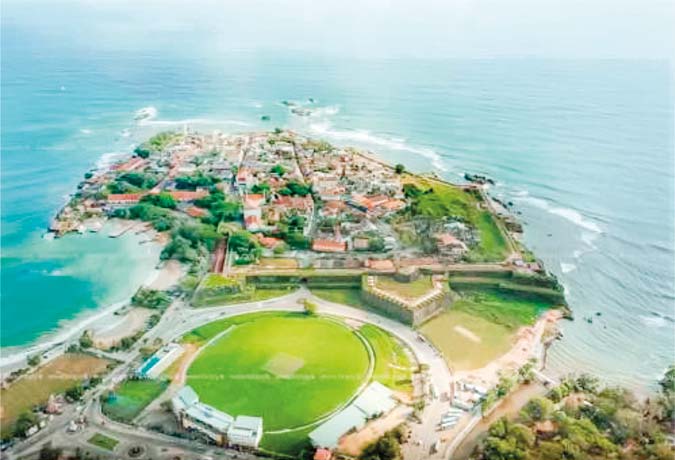
Holidaying in Galle & Colombo, 24 July–4 August 2023
by Ron Slee
of Flinders University & Adelaide
My interest in visiting Sri Lanka has been building for decades, generated by my friendship with two Sri Lankan nationals with whom I play tennis, Michael Roberts and Justin La Brooy. Justin had written me a very helpful short history of the country and added his recommendations of where to see wildlife and scenic beauty and Michael had sent hundreds of photos and personal stories that helped me plan my visit.
Not only was I keen to see where he’d lived and grown up, but Galle Fort is now a UNESCO World Heritage Site. We hired a driver to take us the 120 kms from Colombo (15k rupees for the 2 hrs 15 min drive seemed reasonable) to see what is called the best-preserved colonial town in Sri Lanka. Its history as a fortress dates from 1589 when the Portuguese invaded and built a fort overlooking the harbour. When they were chased out in 1640 by the Dutch, major fortifications including ramparts and surrounding walls were constructed during a 156=year occupation to enclose and protect the peninsula from enemy cannonballs. When the British took over, these walls were retained and did a sterling job keeping the 2004 tsunami at bay (puns intended!).
The Fort is now home to boutique shops and hotels created from historic Dutch and British villas, churches and mansions. Indeed, its history has been well preserved and although it was humid meandering through the narrow colonial streets. I recommend scheduling walks for early morning and evening, making use of your hotel pool to cope with the middle of the day. We stayed at the Galle Fort Hotel, enjoying its colonial grace and charm for considerably less cost than the fashionably genteel Amangalla Hotel a little further along Church Street. Of course, we popped into the Amangalla to compare its atmosphere and to confirm that Leonard Woolf had, indeed, left the building!
Ambling along the hot and shade-less ramparts was a test of our fitness, but the Fort’s entire perimeter is only 3 kms so we were never far from a refreshing lager on a hotel verandah – and from where we could sit and contemplate in which house in Middle Street Michael Roberts had lived, at what age he started drinking tea, tasting cinnamon. We located the Library and the Barefoot Bookshop (unfortunately both were closed) but we wondered at which school he had learnt to read and write. We kept thinking of a young boy diving and swimming at Flag Rock, running laps of the ramparts, playing cricket on one of the ovals.[1] I didn’t see a tennis court, but felt sure we were near where he practised with his first racquet.[2]
The fascinating history of the Fort is on every corner of every street – Church, Lighthouse, Leyn Baan, Hospital, Pedlar, Middle, Queen’s, Rampart, Custom Road [names of streets]. Open to visitors was the oldest Protestant place of worship in Sri Lanka, the Dutch Reformed Church (now Methodist) with its garden of tombstones. Also, the All Saints Anglican Church and the Mosque.
We spent so many hours in the Maritime Museum we left insufficient time for the National Museum and the Historical Mansion Museum.
Our visit to Galle Fort occupied the middle weekend of my wife’s short work contract in Sri Lanka. The rest of the time we spent in Colombo, based at the Galle Face Hotel.
The Galle Face Hotel dates from 1864, “before Lincoln, Pasteur and Marx” (the plaque at its pool eccentrically noted, adding that it’s older than many other famous hotels including the Raffles in Singapore, and that it opened “before the USA purchased Alaska from Russia”).
The hotel proudly promotes itself as a resort, the pool being a conspicuous element. I took advantage of this, indulging almost every day. My routine became a leisurely 3-course buffet breakfast (local fruits – usually papaya and pineapple – followed by a hopper (pancake made of rice-flour, coconut and yeast topped with dahl, seeni sambal – a spicy sweet onion sauce – and a fried egg), followed by crusty bread with ham and cheese (my nod to the Dutch influence) – all washed down with mango juice, coffee and finally a cup of tea. This morning daily banquet was more than enough to tide me over until dinner.
Typically, after breakfast, I would return to our room, collect my bathers and book and repair to the pool which attracted a mix of beached whales, strutters and those of us somewhere along that continuum. I would read poolside with an occasional lap between chapters making sure I was back in the room for a rest before dinner!
I varied this daily routine with tuk-tuk excursions or a browse through the Hotel Museum or watching the 5th Ashes Test, conveniently televised live from 3.30pm local time.
I took 3 separate tuk-tuk tours to various sites in Pettah, the old market area of Colombo, each lasting between 3 and 4 hours. The drivers were experienced guides and showed me through the Buddhist Gangaramaya Temple, the oldest and largest Hindu Temple (Sri Kailawasanathan Swami Devasthanam Kovi), the Red Mosque, shrines (including St Anthony’s Catholic Church where a suicide bomber’s blast killed 93 people on Easter Sunday in 2019), tea stores, spice shops, produce markets and museums including the Independence Commemoration Hall housing their history of political struggles against colonial rule. The National Museum had less focus on political history, more on anthropology, religion, agriculture, migration, and the development of art and crafts, especially fabrics. It was poorly lit in some rooms, but its imposing Victorian exterior is well worth seeing as are its collections of Buddhist statues, kitchen utensils and antique puppets.
I learnt so much from my drivers as we rode and walked around listening to them talk about historic religious, economic and political conflicts, as well as current dilemmas faced by Sri Lanka as it suffers an exodus to other countries of many of its young people and as it becomes over-dependent on foreign investment and loans to save the country from bankruptcy. We got helpful advice from an Australian diplomat about how much we should expect to pay tuk-tuk drivers – for me, this advice came too late, after I’d already been on two quite expensive tours. 10k rupees an hour was too much, I was firmly told!
The Galle Face Museum within the hotel is fascinating, mostly pictures of and autographed messages from famous guests, old newspaper stories about the hotel as well as some odd artefacts. Famous guests included Ernesto Che Guevara who stayed there in 1959 just six years before being killed in Bolivia, Jawaharlal Nehru (’51), Indira Gandhi, Richard Nixon, Clement Attlee (‘40s), Pope John Paul 11 (’95), Yuri Gagarin (in 1961, the year he flew to outer space), Anton Chekhov (1890), Duke Ellington, Dave Brubeck, Don Bradman (’48), Garfield Sobers (’80), Vivien Leigh, Ursula Andress, Scarlett Johansson and Sting. Plus, many tennis players (mostly Australian) and other cricketers.
My offer to add a signed endorsement of our stay in the hotel was politely declined.
A Museum centrepiece is the first car owned by Prince Phillip of Greece (as he was when he went to Colombo to work with Lord Louis Mountbatten in 1940). A 1935 Standard Nine for which he paid 12 Pounds, it’s so tiny I don’t know how he squeezed into it.
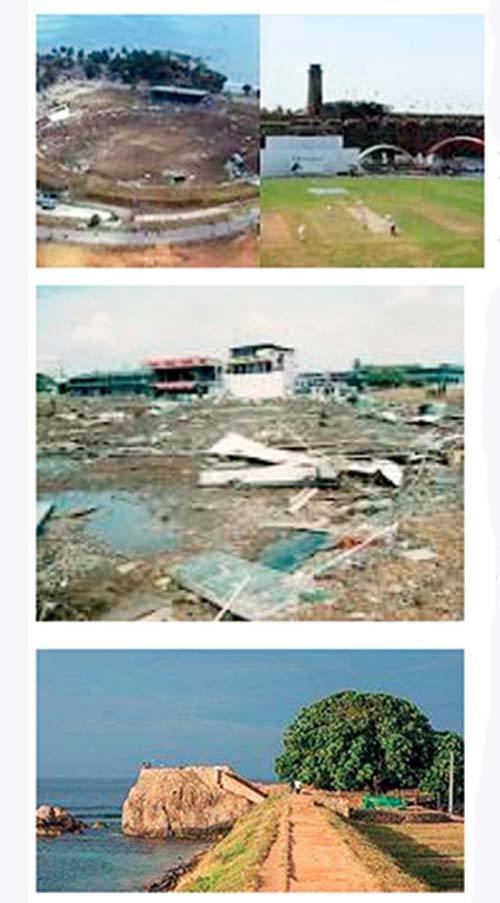 This nod to British colonialism was more than matched by the daily presence during breakfast of a staff member dressed in light-tan knee-length shorts and jacket, a peaked cap and carrying a slingshot. His job was to stop beach gulls flying into the open-air dining veranda to steal food. Each morning he patrolled the lawn between us and the beach while his colleague swept the lawn clean of any stray leaf from nearby palms. Inside, the food staff wore braces over starched white shirts to hold up sharply creased black trousers while the manager in the lobby dressed as if he was going to Royal Ascot. Of course, there is one ubiquitous reminder that some things have changed – they all carry a mobile phone, even the slingshot man!
This nod to British colonialism was more than matched by the daily presence during breakfast of a staff member dressed in light-tan knee-length shorts and jacket, a peaked cap and carrying a slingshot. His job was to stop beach gulls flying into the open-air dining veranda to steal food. Each morning he patrolled the lawn between us and the beach while his colleague swept the lawn clean of any stray leaf from nearby palms. Inside, the food staff wore braces over starched white shirts to hold up sharply creased black trousers while the manager in the lobby dressed as if he was going to Royal Ascot. Of course, there is one ubiquitous reminder that some things have changed – they all carry a mobile phone, even the slingshot man!
Evening meals at the hotel were delicious, especially the local, Indian and Cuban cuisines. The local staple (fish curry and rice) became my preferred dish and after I made an early discovery that a Guinness stout costs half as much as a Corona beer, my preferred beverage became Tiger Beer with Guinness chasers. Taxes make such a difference to the cost of booze.
An important piece of local knowledge I failed to identify early was that every full moon (Poya) is marked with a public holiday and throughout that day no alcohol can be purchased. Except, we discovered, with room service – one way around the obstacle.
We ventured onto the adjacent Galle Face Green to walk amongst the dozens of kite hawkers and food trucks that gather there each evening. The cool night breeze coming off the sea was so refreshing. We spent a memorable evening with Guttila (‘Jay’) Jayatilaka (formerly of the University of Adelaide, Monash University and the University of Sydney) who took us to dinner at the Cinnamon Grand, a short walk from our hotel. Their smorgasbord offered a magnificent range of delicious local cuisines – it was impossible to not overindulge!
Most nights, however, we ate at one of our hotel’s beach-side cafes dressed in summer attire watching the sun set and contemplating our good fortune to be avoiding a cold Adelaide winter.
Sadly, due to work commitments in Colombo we were not able to see Justin La Brooy’s recommendations for wildlife and scenic beauty in the cooler inland parts of the island. As Justin told me before I left “a trip of less than 2 weeks will inevitably leave you short-changed”. I hope to return and rectify that.
I’ll finish this little story of my first visit to Sri Lanka by recommending two books I read while lazing next to the Galle Face Hotel pool.
I took Victoria Glendinning’s biography of Leonard Woolf with me because after graduating from Cambridge, Woolf spent seven years employed by the Colonial Service in Ceylon (1904-11) and returned in 1960 for a brief visit when he was 80 years old. I didn’t get to visit the areas where he worked (Kandy and Hambantota Districts) and that’s one reason I’d like to go back to Sri Lanka – another is to see the state-run elephant orphanage at Pinnawela. My interest in Woolf is partly because my tennis comrade Michael Roberts had interviewed Leonard in 1965 about his time in Sri Lanka and given me the transcript.[3]
The second book, A Fine Balance by Rohinton Mistry is a novel set in India in the mid-1970s. It’s been on my list since it won the 1996 Commonwealth Writers Prize (and was shortlisted for the 1996 Booker) and while visiting South Asia seemed a good time and place to read it.
END NOTES added by Michael Roberts
[1] Courtesy of his partner Joanna’s work assignments in Sri Lanka,
[2] No one dived off Flag Rock then. But we certainly enjoyed the waters and the reef at what was known as the “Girls Bathing Place” about 100 yards away on the western wall where steps enable easy access.
[3] There were three ‘groups’ of tennis courts as one entered the Fort through its central gate: one ‘set’ of three belonging to the Galle Gymkhana Club immediately on the left; another two further to the left and two courts belonging to the Public Services on the immediate right. The Galle Gymkhana Club also had a well-appointed bar with space for two billiard tables and card playing tables, etc, etc. The decline of this club and disappearance of any traces of its imposing presence calls for an essay recording the tale and pondering over the socio-political implications of this set of events.
[4] Readers who wish to access the Leonard Woolf Interview on tape from the ROHP Collection can reach it via (A) the Barr Smith Library Adelaide University … or …. (B) The National Library Services Board off Torrington Road, Colombo 7. Both locations contain the whole stock of recorded interviews gathered by Michael Roberts in the period 1965 to 1969 in England and Ceylon when he was a Lecturer at Peradeniya University (with financial aid provided by the Asia Foundation and the wholesome encouragement of Professor KW Goonewardena and JFK Labrooy of the History Department at Peradeniya Campus.
Features
SL urged to use GSP+ to the fullest to promote export development
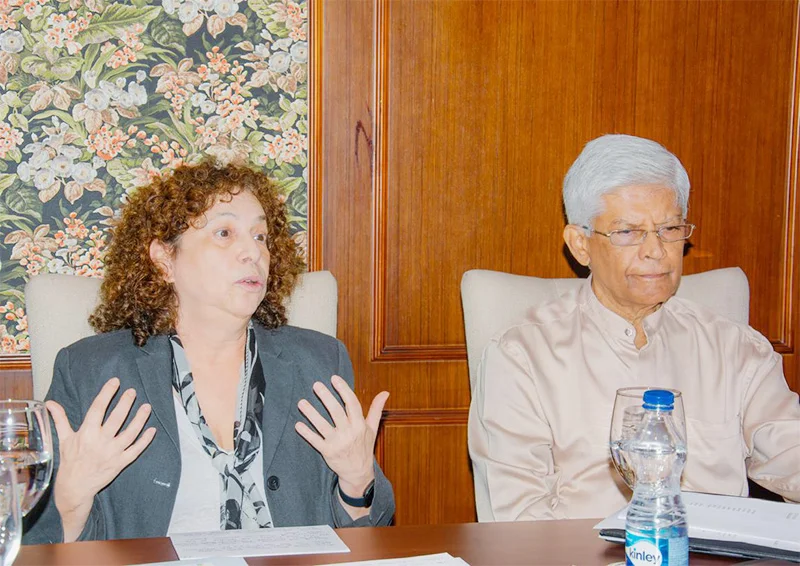
 Sri Lanka needs to take full stock of its current economic situation and use to the maximum the potential in its GSP+ facility for export sector growth. In the process, it should ensure that it cooperates fully with the European Union. The urgency of undertaking these responsibilities is underscored by the issues growing out of the recent US decision to sweepingly hike tariffs on its imports, though differentially.
Sri Lanka needs to take full stock of its current economic situation and use to the maximum the potential in its GSP+ facility for export sector growth. In the process, it should ensure that it cooperates fully with the European Union. The urgency of undertaking these responsibilities is underscored by the issues growing out of the recent US decision to sweepingly hike tariffs on its imports, though differentially.
These were principal ‘takes’ for participants in the Pathfinder Foundation’s Ambassadors’ Roundtable forum held on April 8th at the Colombo Club of the Taj Samudra. The main presenter at the event was Ms. Carmen Moreno Raymundo, Ambassador of the European Union to Sri Lanka and the Maldives. The forum was chaired by Ambassador Bernard Goonetilleke, Chairman, Pathfinder Foundation. The event brought together a cross-section of the local public, including the media.
Ms. Moreno drew attention to the fact Sri Lanka is at present severely under utilizing its GSP+ facility, which is the main means for Sri Lanka to enter the very vast EU market of 450 million people. In fact the EU has been Sri Lanka’s biggest trading partner. In 2023, for instance, total trade between the partners stood at Euros 3.84 billion. There is no greater market but the EU region for Sri Lanka.
‘However, only Sri Lanka’s apparel sector has seen considerable growth over the years. It is the only export sector in Sri Lanka which could be said to be fully developed. However, wider ranging export growth is possible provided Sri Lanka exploits to the fullest the opportunities presented by GSP+.’
Moreno added, among other things: ‘Sri Lanka is one among only eight countries that have been granted the EU’s GSP+ facility. The wide-ranging export possibilities opened by the facility are waiting to be utilized. In the process, the country needs to participate in world trade in a dynamic way. It cannot opt for a closed economy. As long as economic vibrancy remains unachieved, Sri Lanka cannot enter into world trading arrangements from a strong position. Among other things, Sri Lanka must access the tools that will enable it to spot and make full use of export opportunities.
‘Sri Lanka must facilitate the private sector in a major way and make it possible for foreign investors to enter the local economy with no hassle and compete for local business opportunities unfettered. At present, Lanka lacks the relevant legal framework to make all this happen satisfactorily.
‘Sri Lanka cannot opt for what could be seen as opaque arrangements with bilateral economic partners. Transparency must be made to prevail in its dealings with investors and other relevant quarters. It’s the public good that must be ensured. The EU would like to see the local economy further opening up for foreign investment.
‘However, it is important that Sri Lanka cooperates with the EU in the latter’s efforts to bring about beneficial outcomes for Sri Lankans. Cooperation could be ensured by Sri Lanka fully abiding by the EU conditions that are attendant on the granting of GSP+. There are, for example, a number of commitments and international conventions that Sri Lanka signed up to and had promised to implement on its receipt of GSP+ which have hitherto not been complied with. Some of these relate to human rights and labour regulations.
‘Successive governments have pledged to implement these conventions but thus far nothing has happened by way of compliance. GSP+ must be seen as an opportunity and not a threat and by complying with EU conditions the best fruits could be reaped from GSP+. It is relevant to remember that GSP+ was granted to Sri Lanka in 2005. It was suspended five years later and restored in 2017.
‘The importance of compliance with EU conditions is greatly enhanced at present in view of the fact that Sri Lanka is currently being monitored by the EU with regard to compliance ahead of extending GSP+ next year. A report on Sri Lanka is due next year wherein the country’s performance with regard to cooperating with the EU would be assessed. The continuation of the facility depends on the degree of cooperation.
‘A few statistics would bear out the importance of Sri Lanka’s partnership with the EU. For example, under the facility Sri Lanka benefits from duty free access in over 66% of EU tariff lines. The highest number of tourist arrivals in Sri Lanka in 2023 was from the EU’s 27 member states. Likewise, the EU’s 27 member states rank second in the origin of inflows of foreign exchange to Sri Lanka; with Italy, France and Germany figuring as the main countries of origin. Eighty five percent of Sri Lanka’s exports to the EU market benefits from GSP+. Thus, the stakes for the country are high.’
Meanwhile, President, In-house Counsel & Legal Advisor, The European Chamber of Commerce of Sri Lanka, John Wilson said: ‘GSP+ should be seen as not only an opportunity but also as a necessity by Sri Lanka in the current international economic climate. ‘Implementation of local laws is what is needed. Considering the pressures growing out of the US imposed new tariff regime, a good dialogue with the EU is needed.
‘Sri Lanka’s level of business readiness must be upped. Among the imperatives are: An electronic procurement process, Customs reforms, a ‘National Single Window’, stepped-up access to land by investors, for example, a clear policy framework on PPPs and reform of the work permits system.’
It ought to be plain to see from the foregoing that Sri Lanka cannot afford to lose the GSP+ facility if it is stepped-up economic growth that is aimed at. It would be in Sri Lanka’s best interests to remain linked with the EU, considering the aggravated material hardships that could come in the wake of the imposition of the US’ new tariff regime. Sri Lanka would need to remain in a dialogue process with the EU, voice its reservations on matters growing out of GSP+, if any, iron out differences and ensure that its national interest is secured.
Features
SENSITIVE AND PASSIONATE…
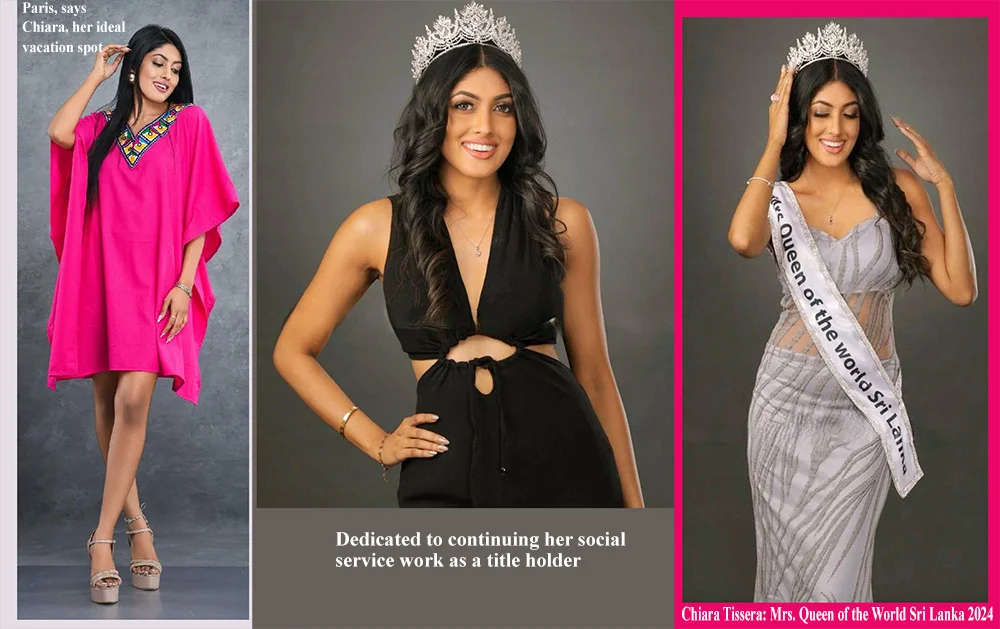
Chit-Chat
Chiara Tissera
Mrs. Queen of the World Sri Lanka 2024, Chiara Tissera, leaves for the finals, in the USA, next month
I had a very interesting chat with her and this is how it all went:
1. How would you describe yourself?
I am a sensitive and passionate individual who deeply cares about the things that matter most to me. I approach life with a heart full of enthusiasm and a desire to make meaningful connections.
2. If you could change one thing about yourself, what would it be?
Actually, I wouldn’t change a thing about myself because the person I am today, both inside and out, is the result of everything I’ve experienced. Every part of me has shaped who I am, so I embrace both my strengths and imperfections as they make me uniquely me.
3. If you could change one thing about your family, what would it be?
If there’s one thing I could change about my family, it would be having my father back with us. Losing him six years ago left a void that can never be filled, but his memory continues to guide and inspire us every day.
4. School?
I went to St. Jude’s College, Kurana, and I’m really proud to say that the lessons I gained during my time there have shaped who I am today. My school and teachers instilled in me values of hard work, perseverance and the importance of community, and I carry those lessons with me every day. I was a senior prefect and was selected the Deputy Head Prefect of our college during my tenure.
5. Happiest moment?
The happiest moment of my life so far has been winning the Mrs. Sri Lanka 2024 for Queen of the World. It was a dream come true and a truly unforgettable experience, one that fills me with pride and gratitude every time I reflect on it.
6. What is your idea of perfect happiness?
Happiness is a deeply personal and multifaceted feeling that often comes from a sense of contentment, fulfillment and well-being. For me, perfect happiness is in moments of joy, peace and accomplishments … and also being surrounded by my loved ones.
7. Are you religious?
Yes, I’m a very religious person. And I’m a firm believer in God. My faith guides me through life, providing strength, dedication and a sense of peace in every situation. I live by the quote, ‘Do your best, and God will do the rest.’
8. Are you superstitious?
I’m not superstitious. I believe in making my own decisions and relying on logic and faith rather than following superstitions.
9. Your ideal guy?
My ideal guy is my husband. He is compassionate, understanding and is always there to support me, no matter what. He’s my rock and my best friend – truly everything I could ever want in a partner.
10. Which living person do you most admire?
The living person I admire the most is definitely my mummy. Her strength, love and unwavering support has shaped me into who I am today. She is my role model and she inspires me every day with her wisdom and kindness.
11. Your most treasured possession?
My most treasured possession is my family. They are the heart of my life, providing me with love, support and strength. Their presence is my greatest blessing.
12. If you were marooned on a desert island, who would you like as your companion?
I would like to have my spouse as my companion. Together, we could make the best of the situation, supporting each other, sharing moments of laughter and finding creative ways to survive and thrive.
13. Your most embarrassing moment?
There’s quite a few, for sure, but nothing is really coming to mind right now.
14. Done anything daring?
Yes, stepping out of my comfort zone and taking part in a pageant. I had no experience and was nervous about putting myself out there, but I decided to challenge myself and go for it. It pushed me to grow in so many ways—learning to embrace confidence, handle pressure, and appreciate my own uniqueness. The experience not only boosted my self-esteem but also taught me the value of taking risks and embracing new opportunities, even when they feel intimidating.”
15. Your ideal vacation?
It would be to Paris. The city has such a magical vibe and, of course, exploring the magical Eiffel Tower is in my bucket list. Especially the city being a mix of history culture and modern life in a way that feels timeless, I find it to be the ideal vacation spot for me.
16. What kind of music are you into?
I love romantic songs. I’m drawn to its emotional depth and the way they express love, longing a connection. Whether it’s a slow ballad, a classic love song or a more modern romantic tune these songs speak to my heart.
17. Favourite radio station?
I don’t have a specific radio station that I like, but I tend to enjoy a variety of stations, depending on my mood. Sometimes I’ll tune into one for a mix of popular hits, other times I might go for something more relaxing, or a station with a certain vibe. So I just like to keep it flexible and switch it up.
18. Favourite TV station?
I hardly find the time to sit down and watch TV. But, whenever I do find a little spare time, I tend to do some spontaneous binge – watching, catching whatever interesting show is on at that moment.
19 What would you like to be born as in your next life?
Mmmm, I’ve actually not thought about it, but I’d love to be born as someone who gets to explore the world freely – perhaps a bird soaring across continents.
20. Any major plans for the future?
Let’s say preparing and participating in the international pageant happening in the USA this May. It’s an exciting opportunity to represent myself and my country on a global stage. Alongside this, I am dedicated to continuing my social service work as a title holder, striving to make a meaningful difference in the lives of others through my platform.
Features
Fresher looking skin …

 The formation of wrinkles and fine lines is part of our ageing process. However, if these wrinkles negatively impact appearance, making one look older than they actually are, then trying out some homemade remedies, I’ve listed for you, this week, may help in giving your skin a fresher look.
The formation of wrinkles and fine lines is part of our ageing process. However, if these wrinkles negatively impact appearance, making one look older than they actually are, then trying out some homemade remedies, I’ve listed for you, this week, may help in giving your skin a fresher look.
* Banana:
Bananas are considered to be our skin’s best friend. They contain natural oils and vitamins that work very perfectly to boost our skin health. Skincare experts recommend applying the banana paste to the skin.
Take a ripe banana and mash a quarter of it until it becomes a smooth paste. Apply a thin layer of the banana paste on your skin and allow it to sit for 15 to 20 minutes before washing it off with warm water.
* Olive Oil:
Olive oil works as a great skin protector and many types of research suggest that even consuming olive oil may protect the skin from developing more wrinkles. Olive oil contains compounds that can increase the skin’s collagen levels. Yes, olive oil can be used as a dressing on your salads, or other food, if you want to consume it, otherwise, you can apply a thin layer of olive oil on your face, neck and hands and let it stay overnight.
* Ginger:
Ginger serves to be a brilliant anti-wrinkle remedy because of the high content of antioxidants in it. Ginger helps in breaking down elastin, which is one of the main reasons for wrinkles. You can have ginger tea or grate ginger and have it with honey, on a regular basis.
* Aloe Vera:
The malic acid present in Aloe Vera helps in improving your skin’s elasticity, which helps in reducing your wrinkles. Apply the gel once you extract it from the plant, and leave it on for 15-20 minutes. You can wash it off with warm water.
* Lemons:
Lemons contain citric acid, which is a strong exfoliant that can help you get rid of your dead skin cells and wrinkles. Also, as an astringent and a cleansing agent, it helps to fade your wrinkles and fine lines. You can gently rub a lemon slice in your wrinkled skin and leave it on for 10-15 minutes. Rinse afterwards and repeat this process two to three times a day.
* Coconut Oil:
Coconut oil contains essential fatty acid that moisturises the skin and helps to retain its elasticity. You can directly apply the coconut oil, and leave it overnight, after gently massaging it, for the best results.
-

 Business3 days ago
Business3 days agoColombo Coffee wins coveted management awards
-

 Business5 days ago
Business5 days agoDaraz Sri Lanka ushers in the New Year with 4.4 Avurudu Wasi Pro Max – Sri Lanka’s biggest online Avurudu sale
-

 Features4 days ago
Features4 days agoStarlink in the Global South
-

 Business6 days ago
Business6 days agoStrengthening SDG integration into provincial planning and development process
-

 Business5 days ago
Business5 days agoNew SL Sovereign Bonds win foreign investor confidence
-

 Features1 day ago
Features1 day agoSri Lanka’s Foreign Policy amid Geopolitical Transformations: 1990-2024 – Part III
-

 Features4 days ago
Features4 days agoModi’s Sri Lanka Sojourn
-

 Midweek Review1 day ago
Midweek Review1 day agoInequality is killing the Middle Class

